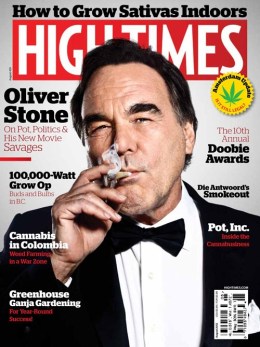
Director Oliver Stone on this 2012 cover of High Times Magazine
Forty years ago a drug-smuggling, leftist radical who went by the alias Tom Forçade launched an underground magazine called High Times. The periodical tapped into a 1970s drug culture that was accepting of marijuana (among other substances), and was a nearly instant success. According to former High Times multimedia director John Holstrom, early editions of the magazine sold more than 1 million copies each, solely through “underground” distribution.
But the fate of High Times tacked closely with the culture’s attitude toward cannabis generally. Forçade committed suicide shortly before the anti-drug movement gained steam in the early 1980s. And as that decade ushered in an era of extremely strict drug laws, the Drug Enforcement Administration launched Operation Green Merchant, which specifically targeted sellers of marijuana-growing equipment who advertised in the magazine. The crackdown was a low point for High Times, and as advertisers fled out of fear of law enforcement scrutiny, it nearly sunk the business entirely.
But High Times remained a trusted source of information for weed enthusiasts and a dogged advocate for ending marijuana prohibition. And as state after state has begun to lift restrictions on cannabis, the publication appears well placed to take advantage of the nascent legitimate pot economy. “We’re the most trusted brand in the business,” boasts High Times publisher Mary McEvoy. “No one else comes close to our integrity for cannabis information distribution.”
Indeed, during a time of rapid retrenchment of the magazine publishing industry, High Times print product is expanding. The company is privately held and doesn’t disclose its circulation figures, but McEvoy says the monthly publication is now boasting 70 to 80 pages of ads per issue, which is up roughly 10% from a year ago. (Meanwhile, publications with flat ad page growth think it victory.) Web traffic has exploded recently as well, from about 1 million monthly unique visitors to 3 million in the past six months.
The legalization of recreational marijuana in Colorado and Washington states, as well as the expansion of legal medical marijuana, has created a steady and growing supply of advertisers wishing to leverage the brand’s reputation with cannabis enthusiasts. McEvoy says their brand is “totally unique,” in the budding cannabis economy because they have a forty-year record. And as more businesses—from glassware manufacturers to companies that make grow-at-home equipment—spring up, they’ll turn to High Times to reach enthusiasts.
Like most publishing companies, however, High Times has been looking beyond the traditional revenue stream of ad sales. And the fastest growing part of the business, according to Matthew Stang, High Times Director of Advertising and New Business, are events. Since 1987, the magazine has been holding its annual “Cannabis Cup,” a multi-day celebration of the cannabis culture and economy in cannabis-friendly Amsterdam, the culmination of which is an awards show in which the best marijuana strains of the year are recognized.
The relaxing of marijuana laws in the United States has allowed the magazine to expand the cannabis cup to various cities in America. Since 2010, High Times has launched festivals in San Francisco, Denver, Los Angeles and Seattle, and is planning to hold its first event in Michigan in July. Tickets for the cup range from $30 for a one-day pass to $200 for a multi-day VIP pass which comes with merchandise and access to special viewing sections for Cannabis-Cup concert performances.
Stang says that these events are just the beginning for the publication’s move beyond traditional print and online advertising revenue. In what is perhaps the company’s most unexpected undertaking, it announced that it would be launching a venture capital vehicle called the HT Growth Fund, which will invest in cannabis-related businesses. According to a recent report in The Denver Post, the goal is to raise upwards of $100 million and invest in companies in $2 million to $5 million increments. Though the HT Growth Fund isn’t the first cannabis-focused venture fund to launch in recent months, the High Times brand could be instrumental in attracting startups that often have nowhere else to turn to for start-up capital because marijuana is still illegal under federal law.
“If you are running a cannabis business, you aren’t getting (a Small Business Administration) loan, you don’t have bank accounts . . . It is hard to grow when you don’t have the tools,” the fund’s managing director, Michael Safir, told The Denver Post.
Stang also says the company is considering moving into television by setting up local channels in states where recreational cannabis is legal, and apparel licensing. And all of these new ventures are buoyed by the increasing acceptance of the drug. Whether its finding freelancers to write for the magazine, or being legally permitted to throw cannabis-themed events, the business of High Times has become a lot easier, and more lucrative, as marijuana prohibition laws become weaker or disappear entirely.
“I remember when stores wouldn’t even carry the magazine unless they were covered in an opaque poly bag and our contributors had to write under pseudonyms out of fear of the police,” says publisher McEvoy. “Now we’ve got people banging down the door hoping to be associated with us.”

